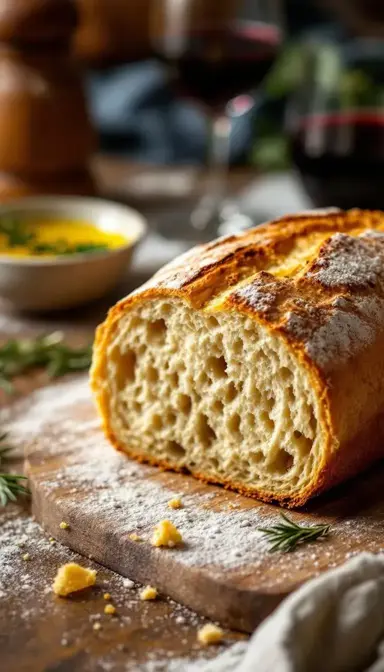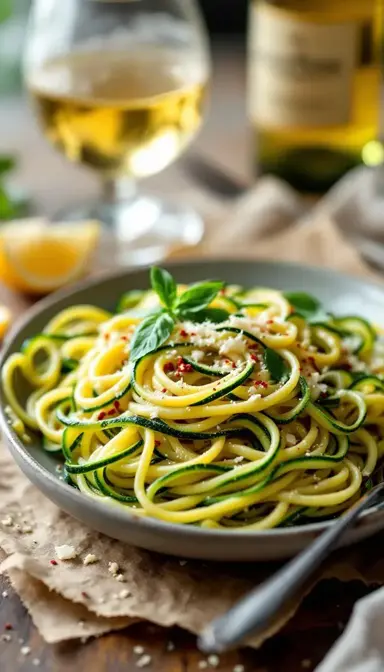There’s something almost magical about pulling a loaf of crusty bread from the oven. That first crackle as the golden crust gives way, the steam rising from the tender, airy crumb inside—it’s a moment of pure kitchen triumph. This recipe is my go-to for that perfect rustic loaf, the kind that makes you feel like you’ve unlocked the secrets of a Parisian bakery with nothing more than flour, water, yeast, and a little patience.
Why This Recipe Works
This isn’t just bread—it’s a lesson in simplicity. Four basic ingredients, no fancy equipment, and a slow, hands-off fermentation process that does all the heavy lifting. The result? A loaf with a crackling crust, an open, airy interior, and a flavor that deepens with every hour it rests.
Essential Ingredients & Tools
Ingredients for the Dough
- 500g bread flour – The high protein content gives structure, but all-purpose flour works in a pinch (just expect a slightly softer crumb).
- 10g salt – Not just for flavor; it keeps the yeast in check.
- 2g instant yeast – A tiny amount does the job over time. If you’re using active dry yeast, let it bloom in warm water first.
- 350ml lukewarm water – The key to hydration. Adjust by a splash if your dough feels too stiff.
Tools
- A Dutch oven or heavy lidded pot – This is your secret weapon for that perfect crust. No Dutch oven? A roasting pan with boiling water on the lower oven rack works too.
- A large mixing bowl – Big enough for the dough to double in size.
- A bench scraper or spatula – Helps shape the dough without overworking it.
- Parchment paper or a clean kitchen towel – Keeps things from sticking when it’s time to bake.
How to Make Crusty Bread
- Mix the Dough – Combine the 500g bread flour, 10g salt, and 2g instant yeast in a bowl. Add the 350ml lukewarm water and stir until you’ve got a shaggy, sticky mess. That’s exactly what you want. Cover it and let it sit at room temperature for 12–18 hours. This long, slow rise is where the magic happens—flavor develops, gluten forms, and those beautiful air pockets start to take shape.
- Shape the Dough – After the first rise, the dough will be bubbly and alive. Flour your surface lightly, turn the dough out (it’ll be sticky—embrace it), and gently fold the edges toward the center to create tension. Flip it seam-side down and let it rest for another 1–2 hours while your Dutch oven preheats to 450°F (230°C).
- Bake to Perfection – Carefully lower the dough into the scorching-hot Dutch oven, slash the top with a razor blade (this lets it expand beautifully), and bake covered for 30 minutes. Remove the lid and bake another 15 minutes until the crust is deep golden and sings when you tap it. Let it cool for at least an hour—I know it’s tempting, but slicing too soon ruins the texture.
Pro Technique
- Steam is Your Friend – The Dutch oven traps steam, giving you that crackly crust. No Dutch oven? Toss a cup of boiling water into a pan on the lower rack of your oven.
- Score with Confidence – A quick, deep slash with a razor blade controls how the bread expands. Angle the blade at 30 degrees for the cleanest cut.
- Patience Pays Off – If your kitchen is cold, let the dough rise longer. A wetter dough (up to 75% hydration) means bigger holes and better flavor.
Chef’s Wisdom
- Dense loaf? It might be underproofed. Use the finger dent test—if the dough springs back halfway, it’s ready.
- Crust too dark? Tent it with foil during the last few minutes of baking.
- Want sourdough? Swap the yeast for 100g of active starter and reduce the water by 20ml.
Storage & Freshness Guide
- Room temperature – Store it cut-side down on a wooden board for up to 2 days. Wrapping it softens the crust.
- Freezing – Slice it, bag it, and freeze for up to 3 months. Reheat straight from frozen in a 350°F (175°C) oven for 5 minutes.
- Never refrigerate – The fridge turns bread stale faster by recrystallizing the starches.
Ingredient Variations and Their Impact
- Whole wheat – Swap half the bread flour for whole wheat, adding a splash more water for hydration.
- Rye – Up to 20% rye flour adds a subtle sourness. Pair it with bread flour for structure.
- Seeded – Fold in toasted sesame or sunflower seeds for extra crunch.
- Herb-infused – Rosemary or thyme steeped in the water adds aromatic depth.
Perfect Pairings
Complementary Dishes
- Whipped ricotta and honey: The creamy, slightly sweet ricotta contrasts with the bread’s crusty bite, while honey adds a floral note. Serve with a drizzle of olive oil and cracked pepper.
- Heirloom Tomato Soup: The bread’s sturdy crumb holds up to dipping, and its mild flavor lets the soup’s acidity shine.
Drinks
- Sauvignon Blanc: The wine’s crisp citrus cuts through the bread’s richness, cleansing the palate.
- Light Pinot Noir: A fruity red with low tannins complements the bread’s toasted notes without overpowering.
Something Sweet
- Dark chocolate and sea salt: A square of high-cocoa chocolate melts slightly on warm bread, balanced by flaky salt.
- Poached Pears with mascarpone: The pears’ delicate sweetness and soft texture pair elegantly with a toasted slice.

The Simple Joy of Crusty Bread: A Homemade Masterpiece
Learn how to bake perfect Crusty Bread at home with just 4 ingredients. Get that crackly crust and soft crumb every time. Start baking now!
Ingredients
Main
-
500 g bread flour
-
10 g salt
-
2 g instant yeast
-
350 ml lukewarm water
Instructions
-
Mix 500g bread flour, 10g salt, and 2g instant yeast in a bowl. Add 350ml lukewarm water and stir until shaggy. Cover and rest 12–18 hours.01
-
Turn dough onto floured surface, fold edges to center, and shape. Rest 1–2 hours.02
-
Preheat Dutch oven to 450°F (230°C). Transfer dough to pot, slash top, and bake covered for 30 minutes.03
-
Uncover and bake 15 more minutes until golden. Cool 1 hour before slicing.04



